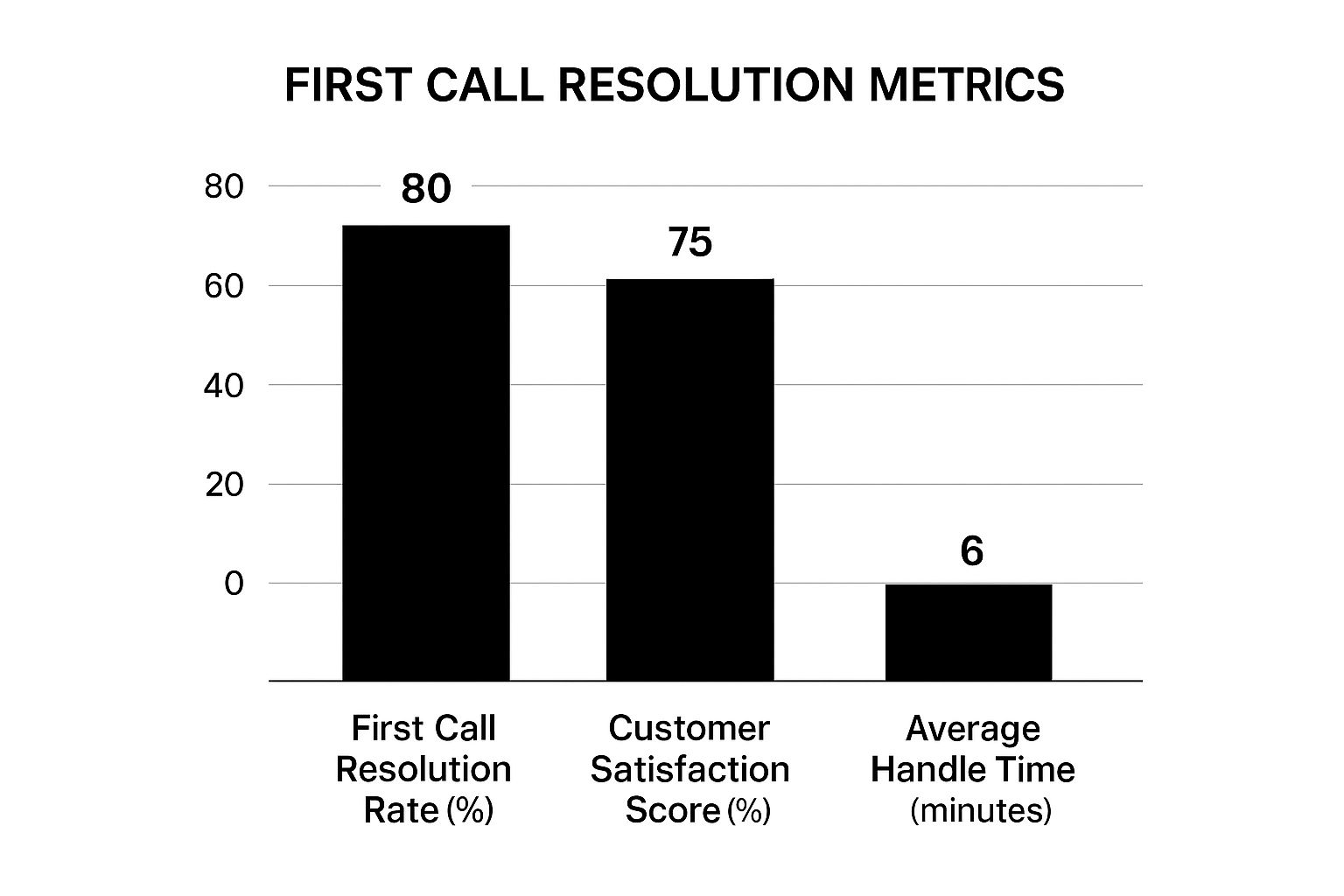Improving your first call resolution (FCR) really comes down to a simple, powerful formula: empower your agents with knowledge, streamline internal processes, and meticulously track what 'resolved' actually means to your customer. This isn't just about getting people off the phone quickly. It's about solving their problems for good on the first try, which is the secret sauce to boosting satisfaction and cutting down on operational costs.
Before you can start improving your first call resolution, you need a crystal-clear understanding of what it is and, just as importantly, what it isn’t. FCR is the percentage of customer issues fully solved during their initial contact, making follow-up calls, emails, or transfers completely unnecessary. Think of a high FCR as a direct reflection of your team's efficiency and a major driver of customer loyalty.
But here’s where many teams stumble: defining what "resolved" truly means. Is it just when an agent clicks a button and closes a ticket? Or is it when the customer hangs up feeling their problem is actually solved? The best approach always, always prioritizes the customer’s point of view. After all, if a customer has to call back, the issue wasn't truly resolved, no matter what your CRM says.
Knowing where you stand is the essential first step toward getting better. The industry-wide average FCR rate hovers around 70%. That means roughly one in three customers has to reach out a second time. This number can swing quite a bit depending on the industry because of how complex the typical problems are.
For example, retail support often hits FCR rates around 78%, while the tech sector averages closer to 65% due to more intricate, multi-step issues.
To give you a clearer picture, here’s a quick breakdown of what you might see.
This table breaks down average FCR rates across different industries and for various types of customer calls, highlighting areas with the most room for improvement.
As you can see, simpler, more transactional calls have a much higher natural FCR rate than complex troubleshooting. This data helps set realistic goals for your team based on the kinds of calls you receive most often.
A key insight I've learned over the years is that chasing a perfect 100% FCR is actually counterproductive. Some problems are just too complex and need escalation or follow-up. The real goal is to optimize the issues you can solve on the first go and build smooth, efficient pathways for the ones you can't. Don't push agents to rush every call to a premature close.
This visual shows just how tightly FCR is linked to other crucial metrics like customer satisfaction.

It’s pretty clear: as FCR goes up, so does customer satisfaction, even if it means the average call takes a little longer. It's a trade-off worth making.
Getting an accurate read on your FCR requires a smart mix of internal data and external feedback. If you only rely on one, you'll get a skewed picture of how you're really doing.
Here are the most reliable methods I've seen work in practice:
When you combine these different methods, you get a much more complete and accurate view of your resolution performance. For a deeper dive into turning this data into real-world improvements, check out our guide on the top 7 first call resolution best practices.

Even with the best processes in place, your agents are the ones on the front lines driving first call resolution. A well-meaning agent who doesn't have the right knowledge or authority is ultimately set up to fail, leading to escalations and justifiably frustrated customers. To really move the needle on FCR, you need to shift from just enforcing scripts to truly empowering your team.
This means turning your agents from simple information relays into genuine problem-solvers. The end goal is to equip them so thoroughly that they can handle almost any issue on their own, making follow-up calls a rarity instead of the norm.
A surface-level understanding of your products is a one-way ticket to low FCR. When an agent only knows the basics, any question with a bit of complexity forces a transfer or a dreaded "I'll have to call you back." That’s why comprehensive training isn't just about onboarding; it's the bedrock of agent confidence.
Forget one-and-done training sessions. Instead, build a culture of continuous learning. This could look like regular mini-sessions on new product features, deep dives into common troubleshooting problems, or quick updates on policy changes. The more intimately familiar your agents are with the ins and outs of what you offer, the faster they can diagnose and solve issues.
Think about it. A customer calls about a billing discrepancy on their software subscription. An agent with basic training might only be able to confirm the charge exists. But an expert agent can:
That single interaction turns a potential complaint into a resolved issue and a happy customer. All in one call.
Agents shouldn't have to play detective, hunting for answers across scattered documents, outdated spreadsheets, or by shouting questions over the cubicle wall. That wasted time tanks your handle time and kills the chance of a first call resolution. The solution? Build and maintain a centralized, easily searchable knowledge base.
This "single source of truth" needs to be the first and only place an agent has to look. It must be obsessively maintained, updated in real-time, and organized so intuitively that finding an answer is second nature.
A powerful knowledge base isn't just a collection of documents; it's an agent's most trusted partner. When an agent trusts the information is accurate and easy to find, their confidence soars, and they can focus on the customer, not the hunt for answers.
For instance, a customer calls because their new smart thermostat won’t connect to Wi-Fi. A rock-solid knowledge base lets the agent search "Wi-Fi connection issue" and immediately pull up a step-by-step troubleshooting guide, complete with common error codes and their fixes. The agent can then confidently walk the customer through the solution without ever needing to escalate to a technical team.
Product knowledge is only half the equation. How an agent communicates is just as vital for hitting your FCR targets. A frustrated or confused customer needs more than a technically correct answer; they need to feel heard and understood. This is where soft skills training becomes absolutely essential.
You'll want to focus your training on these key areas:
Investing in these skills is a core part of building a resilient, high-performing team. You can explore more tactics in our complete guide to call center workforce management, which digs deeper into how you can build and maintain a team that consistently delivers.

Even the most empowered agents can't overcome broken internal systems. A high first call resolution (FCR) rate is almost always a direct reflection of smart, efficient processes that remove friction. When agents have to jump through hoops just to find an answer or get an approval, it’s the customer who pays the price with their time—and that’s a direct cause of repeat calls.
The goal is to build an operational backbone that makes one-call resolutions the path of least resistance. This means digging into your call data to find the real issues, refining how you route inquiries, and building seamless communication channels between your teams.
Your call logs are an absolute goldmine. They point directly to the friction points that force customers to call back. Don't just stare at your FCR rate as a single metric; you have to dig deeper to understand the why behind every unresolved call.
Start by analyzing the calls that weren't resolved on the first try. Look for patterns. Are customers repeatedly calling about the same complex billing issue or a specific technical glitch? This kind of analysis helps you stop treating symptoms and start fixing the core problem.
A common mistake I see is managers blaming agents for low FCR without ever looking at the system. The truth is, research shows that nearly 50% of repeat calls stem from organizational policies or process failures, not agent error. The data will tell you exactly where your processes are breaking down.
For instance, if you discover that 20% of all repeat calls are from customers asking about shipping status, that isn't a training issue. It's a huge flashing sign that you need a better, more proactive communication system for shipping updates, like automated texts or email alerts. That one process change can eliminate a massive chunk of your inbound calls entirely.
Getting the customer to the right person from the very start is one of the most powerful things you can do to boost FCR. A generic "press one for support" menu is a recipe for transfers, hold times, and frustrated customers. The objective is to match a customer's specific need with an agent who has the specific skills to solve it.
This is where skill-based routing really shines. Instead of one general queue, you can create specialized groups:
By using an intelligent system, you can direct callers to these specialized queues based on their IVR choices or even the number they dialed. This makes it far more likely that the first person they speak to is the only person they need to speak to. You can get a better sense of how modern systems do this by reading up on how AI call routing works and what it takes to implement.
Your front-line agents can't be an island. They frequently need quick answers or help from other teams like billing, logistics, or tier-2 technical support. When those communication lines are slow or tangled in bureaucracy, the customer is the one left on hold, and your chance for a first call resolution simply vanishes.
You have to create clear and fast communication pathways. This doesn't need to be overly complicated. It could be a dedicated Slack channel where support agents get immediate answers from senior technicians. Or maybe it's a streamlined escalation process that guarantees a response from the billing team in minutes, not hours.
Think about this real-world scenario: a customer calls because their payment was declined, but their bank shows the funds were taken. The front-line agent sees the declined transaction but has zero visibility into what's happening with the payment processor.
Giving your agents better training and cleaning up your internal processes will get you some solid wins, but technology is where you can find some truly game-changing improvements. Having the right tools isn't just a nice-to-have anymore; it's a must if you're serious about nailing first call resolution. The idea is to build a support system where tech helps both your team and your customers, making every interaction faster and more effective.
This is about more than just a standard CRM. It’s about smart systems—AI assistants, intelligent Interactive Voice Response (IVR), and integrated platforms that can handle the simple stuff automatically and give your agents superpowers for the complex problems.
A huge chunk of your calls are probably for simple, repetitive questions. "What are your hours?" "Where are you located?" "What's my account balance?" These calls are easy, but they clog up the phone lines and keep your agents from tackling the tough issues that actually require a human touch.
This is exactly what AI was made for. An AI-powered virtual receptionist or a well-designed IVR can field these basic questions 24/7 without anyone on your team lifting a finger. This immediately frees up your agents to focus on the messy, complicated calls—the very ones that are most at risk of needing a follow-up.
Think about it this way:
When you multiply that small-time saving by hundreds or thousands of calls, you see a massive impact on your agents' availability for the calls that truly matter.
The most successful teams I've seen use AI as their first line of defense. By filtering out all the low-hanging fruit, you create a cleaner, more focused queue for your human agents, which directly helps them solve more of their calls on the first try.
Even your most seasoned agent can't possibly memorize every policy update, product spec, or promotional detail. When a customer throws them a curveball, what happens? They put the customer on hold while they scramble to find an answer in a knowledge base or ping a supervisor. That hold time is an FCR killer.
But modern tech can act as a co-pilot, feeding agents the right information at the exact moment they need it. During a live conversation, AI tools can listen for keywords and automatically push relevant articles, customer data, and process guides to the agent’s screen.
Imagine an agent is talking to a customer about a tricky warranty claim. The AI could instantly display:
This real-time backup eliminates the need for awkward pauses and frantic searching, empowering your agent to give a quick, confident, and correct answer. Some businesses are even using an AI receptionist for small businesses that not only triages initial calls but also pre-loads this kind of context before an agent even picks up the phone.
Your call recordings are an absolute goldmine of information, but who has time to manually listen to thousands of hours of audio? It's impossible. This is where AI-powered analytics completely changes the game for improving FCR.
These tools can transcribe and analyze 100% of your calls, spotting patterns, friction points, and recurring problems that you’d otherwise never notice. This analysis can uncover things like:
By turning all that unstructured audio into real, actionable data, you can stop just reacting to problems and start proactively fixing the root causes of repeat calls.

If you're treating every incoming call the same way, you're setting your team up for failure and frustrating your customers. It's a classic mistake. The agent who can brilliantly handle a simple billing question might not have the temperament or deep technical knowledge to de-escalate a complex product complaint.
To really move the needle on first call resolution, you have to get past the one-size-fits-all mindset. The key is to start segmenting your calls. This means digging into your data to understand the different types of issues your customers are calling about. Once you see the massive difference between a password reset and a product failure, you can build specialized paths to resolve each one effectively.
First things first, you need to figure out what people are actually calling you about. Your own call logs and CRM data are a goldmine for this. Start looking for recurring themes and group them into logical buckets.
Most businesses find their calls naturally fall into a few key categories:
Once you’ve got these categories defined, you can analyze the FCR rate for each one. The data will immediately point you to your biggest opportunities and your biggest headaches.
It's not just a gut feeling; the data proves that not all calls are created equal. Research shows that general inquiries and account maintenance tasks often hit FCR rates above 70%. But for tougher issues, the numbers drop off a cliff. Calls about claims can dip to 59%, and complex complaints? They plummet to an average FCR of just 47%.
This is a huge deal. It highlights why a specialized approach is so critical, especially for complaints. If you don't solve it on that first call, you're practically inviting that customer to leave. You can dig deeper into the numbers by checking out this detailed analysis of call resolution rates.
I’ve seen this firsthand. A team I was working with had a dismal overall FCR. But when we broke down the data, we found their agents were absolute rockstars with billing inquiries, hitting an 85% FCR. The real problem was technical support, which was dragging the whole average down. This insight meant they could stop wasting money on generic retraining and instead build a specialized tech support group with advanced skills.
Okay, so you've identified your call types and their unique FCR challenges. What now? It’s time to create targeted strategies for each one. This isn’t about hiring an army of new agents; it’s about organizing your current team much more intelligently.
This is where you build dedicated skill groups.
For each of these groups, you’ll want to develop specialized workflows. Create dedicated sections in your knowledge base with step-by-step guides just for them. Crucially, you also need to give them the right level of authority. Your Resolution Team, for example, should be empowered to offer credits or solutions without having to get a manager's sign-off—a classic roadblock to first call resolution.
By matching the right agent to the right call, you create an environment where resolving issues on the first try becomes the norm, not the exception.
Even with a solid plan, a few questions always pop up when teams get serious about boosting their first call resolution. Getting clear, straightforward answers can help you dodge common mistakes and focus your energy where it counts.
The industry average for FCR hangs around 70%, so anything between 70% and 79% is generally considered pretty good. Hitting this sweet spot shows your team is consistently knocking out most issues on the first try.
But if you're aiming for the top, the "world-class" FCR rate is 80% or higher. That's a tough benchmark to hit—only about 5% of call centers ever get there. Your target really depends on your industry. A retail business might realistically shoot for 80%, but a tech company wrestling with complex software bugs might set a strong goal at 70%.
The most important thing? Just focus on steady improvement from where you are right now.
This is a tough one. Customer complaints have a notoriously low average FCR rate of only 47%. You can't just treat these calls like any other; they need their own dedicated strategy.
A focused approach for handling complaints should include a few key things:
Honestly, it can go either way. An IVR's impact on your FCR depends entirely on how you set it up. A badly designed IVR with confusing menus, endless loops, and long waits will absolutely tank your FCR by frustrating customers before they even reach a human.
The biggest mistake we see is when companies focus too much on cutting down call times instead of actually solving problems. Pressuring agents to wrap up calls quickly just leads to half-baked solutions and callbacks, which is the exact opposite of what you want.
On the other hand, a smart, well-designed IVR can be a huge asset. It can actually boost your FCR by:
The trick is to think of your IVR as a tool to help the customer, not a wall to keep them away from your team.
My AI Front Desk can field these routine inquiries 24/7, giving your customers instant answers while your human agents focus on the complex issues that truly need their expertise. See how our AI-powered solutions can transform your customer experience by learning more at https://myaifrontdesk.com.
Start your free trial for My AI Front Desk today, it takes minutes to setup!








